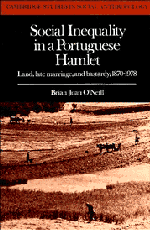Book contents
- Frontmatter
- Contents
- List of tables
- List of figures
- List of illustrations
- List of plates
- Acknowledgements
- 1 An ‘egalitarian’ Iberian community?
- 2 Open fields and communal land
- 3 Social groups
- 4 Cooperative labour
- 5 Matrimony and patrimony
- 6 Minimal marriage
- 7 The fulcrum of inheritance
- 8 Conclusion
- Appendix I The landholding survey
- Appendix II Social groups in 1851 and 1892
- Appendix III The Parish Register
- Appendix IV Household structure, 1977
- Appendix V Baptisms of bastards, 1870–1978
- Glossary of Portuguese terms
- Bibliography
- Index
- Cambridge Studies in Social Anthropology
Appendix V - Baptisms of bastards, 1870–1978
Published online by Cambridge University Press: 11 October 2009
- Frontmatter
- Contents
- List of tables
- List of figures
- List of illustrations
- List of plates
- Acknowledgements
- 1 An ‘egalitarian’ Iberian community?
- 2 Open fields and communal land
- 3 Social groups
- 4 Cooperative labour
- 5 Matrimony and patrimony
- 6 Minimal marriage
- 7 The fulcrum of inheritance
- 8 Conclusion
- Appendix I The landholding survey
- Appendix II Social groups in 1851 and 1892
- Appendix III The Parish Register
- Appendix IV Household structure, 1977
- Appendix V Baptisms of bastards, 1870–1978
- Glossary of Portuguese terms
- Bibliography
- Index
- Cambridge Studies in Social Anthropology
Summary
Illegitimacy ratios in Fontelas are so high that they tempt a complete questioning of the reliability of the Parish Register data. I have compiled this appendix in order to dispel such doubts. The first two tables below (22 and 23) list the occupations of the mothers and fathers of illegitimate children since 1870. Following these tables I have listed all of the baptisms recorded in Fontelas over the three decades beginning in 1880, 1910, and 1950. These three decades provide a good sample of the completeness of the recording of bastard baptisms over the last century. I have compiled similar lists for all 11 decades since 1870, but include only three here. The baptismal entries are extraordinarily detailed and to a great degree reliable. Furthermore, they can be supplemented through a simple record linkage of named individuals with three further documentary sources: the marriage entries, the death entries, and the Confessional Rolls. The baptismal entries thus provide us with a mine of information concerning bastardy and its occurrence within various social groups over time.
There are six major ways to confirm that the status of a natural child has been correctly recorded in the baptismal entry. Firstly, the standard phrase pai incógnito (unknown father) is normally written in the entry immediately following the words ‘illegitimate child of …’ Thus a bastard will be described as an ‘illegitimate son of T.P., single Jornaleira, born and resident in Fontelas, and of an unknown father…’ (see the transcription of a complete sample entry of a bastard baptism in Appendix III).
- Type
- Chapter
- Information
- Social Inequality in a Portuguese HamletLand, Late Marriage, and Bastardy, 1870–1978, pp. 386 - 395Publisher: Cambridge University PressPrint publication year: 1987



